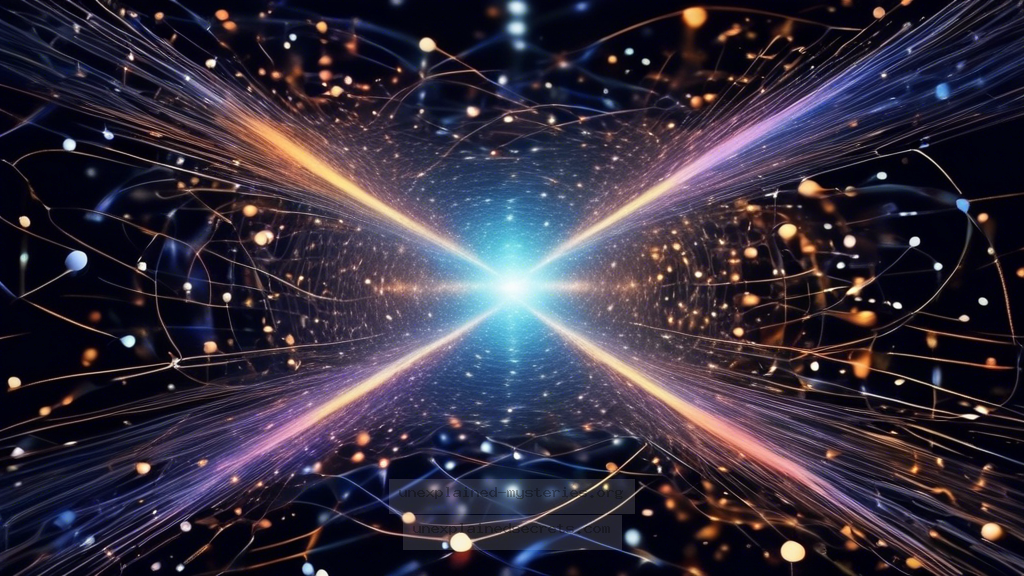What Lies Beyond the Standard Model of Particle Physics: Are There Hidden Dimensions?
What Lies Beyond the Standard Model of Particle Physics: Are There Hidden Dimensions?
The realm of particle physics has long fascinated scientists and enthusiasts alike. At its core lies the Standard Model, a theory that encapsulates our understanding of fundamental particles and their interactions. However, the question of whether hidden dimensions exist beyond this model challenges our current understanding and invites us to explore the very fabric of the universe. This mystery not only captivates theoretical physicists but also has profound implications for our understanding of reality. So, what exactly are these hidden dimensions, and why do they matter? Let’s delve deeper into this scientific enigma.
Historical Context of the Standard Model
The Standard Model of particle physics, developed in the mid-20th century, describes how elementary particles interact through fundamental forces. It successfully categorizes all known particles, including quarks, leptons, and gauge bosons. The model has been validated through extensive experimental evidence, most notably with the discovery of the Higgs boson at CERN in 2012. However, despite its success, the Standard Model has limitations: it does not incorporate gravity, dark matter, or dark energy, which comprise most of the universe’s mass-energy content.
These gaps in the model have prompted physicists to look beyond its confines for answers. Various theories, including string theory and M-theory, posit the existence of extra dimensions that could help unify all fundamental forces. The idea of hidden dimensions is not merely speculative; it could provide a more comprehensive framework for understanding the universe.
Core Concepts: What Are Hidden Dimensions?
Hidden dimensions are theoretical constructs that suggest the existence of spatial dimensions beyond the familiar three (length, width, height) and time. In string theory, for instance, particles are not point-like but rather tiny vibrating strings that exist in multiple dimensions. The additional dimensions could be compactified, meaning they are curled up and not directly observable at macroscopic scales.
In string theory, the minimum number of dimensions required is ten, including the three dimensions of space and one of time. The remaining six dimensions could provide the necessary framework for unifying gravity with quantum mechanics. The implications of these hidden dimensions challenge our intuitive understanding of space and time, pushing the boundaries of modern physics.
Real-World Examples of Theoretical Models
One of the most compelling examples of hidden dimensions comes from string theory. The theory posits that the fundamental forces of nature arise from the vibrations of these strings in higher-dimensional space. For instance, the strength of gravity could be influenced by how these extra dimensions are shaped and compactified.
| Dimension Type | Description | Significance |
|---|---|---|
| 0D | Point particles | Basic building blocks of matter |
| 1D | Strings | Vibrating entities that represent particles |
| 2D | Branes | Higher-dimensional objects where strings can end |
| 3D+ | Compactified dimensions | Unifying all forces of nature |
Moreover, theories like the Randall-Sundrum model propose scenarios where our universe could be a three-dimensional “brane” embedded in a higher-dimensional space. These models offer potential explanations for the observed weakness of gravity compared to other fundamental forces, such as electromagnetism.
Practical Implications: Testing Hidden Dimensions
Testing for hidden dimensions remains one of the most significant challenges in modern physics. However, researchers are devising innovative experiments to explore these theories. One approach involves high-energy particle collisions, such as those conducted at the Large Hadron Collider (LHC). By smashing particles together at unprecedented energies, scientists hope to discover evidence of extra dimensions through the production of micro black holes or other unique signatures.
Another avenue of investigation is gravitational wave detection. The Laser Interferometer Gravitational-Wave Observatory (LIGO) has already revolutionized our understanding of gravity, and future experiments could potentially reveal anomalies indicative of additional dimensions. For instance, if gravitational waves interact with hidden dimensions, we might observe deviations from expected waveforms.
Alternative Perspectives: Critiques and Counterarguments
While the concept of hidden dimensions is intriguing, it is not without its critics. Some physicists argue that the lack of empirical evidence for extra dimensions raises doubts about their existence. Theoretical models can become increasingly complex, often leading to the “multiverse” hypothesis, which suggests that our universe may be one of many with different physical laws. However, this notion complicates the scientific method, as many aspects of the multiverse are inherently untestable.
Moreover, some researchers advocate for simpler explanations within the framework of the Standard Model. They argue that anomalies and unexplained phenomena might be addressed without invoking hidden dimensions. For example, the search for dark matter has led to numerous experiments looking for weakly interacting massive particles (WIMPs) rather than exploring dimensions beyond our observable universe.
Common Misconceptions About Hidden Dimensions
Misconception: Hidden dimensions are the same as parallel universes.
Clarification: While both concepts involve additional realms beyond our observable universe, hidden dimensions refer to extra spatial dimensions that are compactified, whereas parallel universes suggest alternate realities with different physical laws.
Misconception: The existence of hidden dimensions is purely speculative.
Clarification: Although challenging to test, theories involving hidden dimensions are grounded in established physics and are actively researched in theoretical frameworks like string theory and M-theory.
Best Practices for Investigating Hidden Dimensions
For those interested in exploring the concept of hidden dimensions, several best practices can enhance understanding and investigation:
- Stay Informed: Follow the latest developments in particle physics through reputable scientific journals and conferences.
- Engage with Theoretical Physics: Familiarize yourself with concepts in string theory and quantum mechanics to grasp the underlying principles of hidden dimensions.
- Participate in Research: If possible, engage in research projects or internships related to particle physics or astrophysics.
- Connect with Experts: Attend lectures or seminars featuring physicists who specialize in theoretical models involving extra dimensions.
Future Developments: Ongoing Research and Discoveries
As research continues, the pursuit of understanding hidden dimensions remains a leading edge of theoretical physics. The next generation of particle accelerators, such as the proposed Future Circular Collider (FCC), aims to probe higher energies, potentially unveiling evidence of extra dimensions. Additionally, advancements in gravitational wave astronomy and multi-messenger astrophysics present new opportunities to test theories concerning hidden dimensions.
Future explorations could also involve a deeper understanding of dark matter and dark energy, as researchers seek to uncover whether these elusive entities are related to hidden dimensions. The interplay between cosmology and particle physics may unveil new insights, providing a comprehensive picture of the universe’s fundamental structure.
Conclusion: The Quest for Understanding Continues
The question of whether hidden dimensions exist beyond the Standard Model of particle physics invites us to reconsider our understanding of reality. While the theories surrounding extra dimensions open up exciting possibilities, they also confront us with challenges and debates within the scientific community. As research progresses, we may inch closer to unraveling the mysteries of the universe, potentially reshaping our understanding of space, time, and the fundamental forces that govern existence.
In summary, the exploration of hidden dimensions encompasses historical context, core concepts, real-world examples, practical implications, alternative perspectives, and ongoing research. Whether through high-energy collisions or gravitational wave observation, the quest to understand the hidden layers of our universe continues to inspire scientists and curious minds alike. 🌌✨
Other Articles
Recent Posts
- What Happened to Flight MH370? The Conspiracy Theories That Still Haunt Us
- What Secrets Lurk Within the Walls of the Infamous Trans-Allegheny Lunatic Asylum?
- What Evidence Supports the Existence of Bigfoot in the Pacific Northwest?
- What Happened to the Indus Valley Civilization? Unraveling the Mysteries of Ancient Urban Life
- Can Telepathy Be Scientifically Proven Through Laboratory Evidence?







